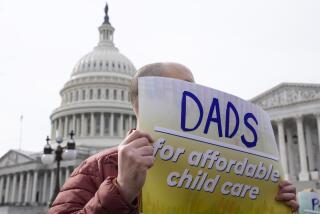A Chance to Critique Child Care
Readers of Soap Opera Digest, Rolling Stone and Baby Talk probably don’t get many chances to influence public policy.
But they will early next year when those magazines and as many as 20 others with a combined circulation of more than 41.3 million carry a questionnaire designed to give their readers input on President-elect Bush’s stance on child care.
The survey, dubbed “Tell the President: Your Family Matters,” asks readers to complete a 19-item questionnaire on matters such as whether “the federal government should develop policies to make child care more available and affordable.” Other questions include whether job security should be guaranteed for parents who take child-care leave, whether such leave should be paid, whether employers should make “child care more available and affordable,” and whether the federal government should set minimum standards for child-care centers.
Coalition of Activists
Results are to be presented to the new President next May, after they have been compiled by an independent auditor. No one’s sure what to expect in terms of response but there’s one estimate that 200,000 or more surveys will be returned.
The survey is a joint venture by a coalition of child-care activists, including some Southern Californians. It follows an initial effort by one coalition member--the Great American Family Tour--to bring family issues to the fore during the presidential primary season earlier this year. The second member of the coalition is the Child Care Action Campaign, based in New York, whose members include leaders from business, labor, the media, public service and child-care organizations. There also is a television component with the Lifetime cable network set to publicize the survey and child-care issues through a special to be aired in January and public service announcements.
Family Issues Highlighted
The Great American Family Tour is a nonpartisan, nonprofit group that helped highlight family issues through a series of forums and public meetings in presidential primary states, a tactic that drew a surprisingly strong response, especially from young families, according to tour member Diana Meehan, director of USC’s Institute for the Study of Women and Men. Rep. Pat Schroeder (D-Colo.), probably is the best-known tour member. Early next year, Schroeder’s book on family issues, “Champion of the Great American Family,” will be published by Random House. Other tour leaders are well-known pediatrician Dr. T. Berry Brazelton, who hosts a program on Lifetime, and “Family Ties” producer Gary David Goldberg.
The action campaign’s board, which includes a number of publishing heavyweights, such as John Mack Carter of Good Housekeeping, was instrumental in obtaining the cooperation of the magazines, said the group’s spokesperson, Amy Moore.
In addition to Soap Opera Digest, Rolling Stone, Baby Talk, and Good Housekeeping, magazines that will carry the survey are: Family Circle, Ms., Ladies’ Home Journal, Working Mother, Changing Times, Essence, Redbook, American Baby, Better Homes and Gardens, Mothers Today & Working Parents, Executive Female, Money, Vista and Parents. The survey will appear in January, February or March issues of the magazines.
People magazine may be added to the list, Moore said, adding that some surveys have already been returned from the January issue of Ladies’ Home Journal.
Time for Phoenix Parents
While child-rearing may be an economic burden for some families and a national political issue for many, it also is an opportunity for others. In late April the publishers of L.A. Parent magazine plan to increase their family of three publications to four when they debut a Phoenix-area edition, to be named Phoenix Parent or Phoenix Family.
Currently, L.A. Parent, Parenting (covering Orange County) and San Diego Parent claim about 200,000 in circulation in Southern California.
The magazines are a blend of topics, such as “The Child as Actor,” children’s fashion, childbirth and a child’s fantasy world combined with an extensive calendar listing of children’s events. A celebrity parent is often featured on the covers.
Editor Jack Bierman says the calendar is “the most important part” of the magazines and the feature that requires the most work, at least initially.
Bierman has a different attitude about his magazines, noting that readers are motivated more by their own responsibilities than the contents about “esoteric birthing classes.” He added, “It’s not interesting reading. You make a sacrifice just by picking it up.”
Ironically, when Bierman started what became L.A. Parent more than eight years ago, he was an unmarried graduate student. His collaborators discussed a variety of ideas, including a trucking publication, telling each other, “We can do stories about tires and things like that.”
Savvy Picks for the ‘90s
The current issue of Savvy Woman offers both encouragement and warnings for American women who are worried about the next decade.
Drawing from a variety of sources and experts, the magazine’s lengthy peek at the 1990s includes a list of the editors’ 10 favorite predictions. At the top of the list: “Labor shortages will force employers to pay women almost as much as men.”
Second, the magazine boldly maintains that “a truce will be declared in the war on cellulite.” Americans will become more tolerant of more-than-lean bodies as the population ages and discovers that no amount of exercise will reverse mortality or make them look younger than they are.
Other top 10 predictions include: less fashionable, more functional clothing will become the norm; computers that recognize human speech will “revolutionize the office,” and an end to the Cold War.
More ominously, the magazine asserts that “The clearest foretaste of what’s to come in pop culture is found on Saturday morning cartoons.” Television expert Mark Crispin Miller told the magazine that “Children’s entertainment is becoming much less coherent as narrative. It’s more and more a string of little visual jolts and bursts of action.”
More to Read
Get the L.A. Times Politics newsletter
Deeply reported insights into legislation, politics and policy from Sacramento, Washington and beyond. In your inbox three times per week.
You may occasionally receive promotional content from the Los Angeles Times.










